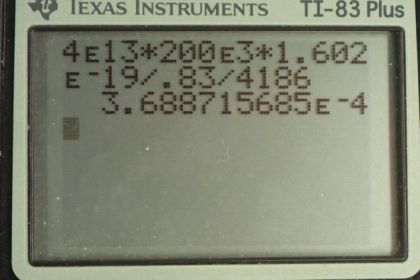Question
One problem with x-rays is that they are not sensed. Calculate the temperature increase of a researcher exposed in a few seconds to a nearly fatal accidental dose of x-rays under the following conditions. The energy of the x-ray photons is 200 keV, and of them are absorbed per kilogram of tissue, the specific heat of which is . (Note that medical diagnostic x-ray machines cannot produce an intensity this great.)
Final Answer
Solution video
OpenStax College Physics, Chapter 29, Problem 83 (Problems & Exercises)

vote with a rating of
votes with an average rating of
.
Calculator Screenshots
Video Transcript
This is College Physics Answers with Shaun Dychko. A researcher is exposed to x-ray photons that each have an energy of 200 kiloelectron volts and there are 4 times 10 to the 13 photons absorbed, per kilogram, of mass of the researcher. And the specific heat of the researcher's tissue is 0.830 kilocalories per kilogram per Celsius degree. And the heat energy absorbed equals the mass of the researcher times the specific heat times the change in temperature and it's this change in temperature that we want to find in this question; how much will their tissue change in temperature after absorbing a certain number of photons? After absorbing 4 times 10 to the 13 photons per kilogram. So the total energy absorbed will also be the number of photons multiplied by the energy per photon and the energy per photon is given here. So we can substitute this in place of E in our heat formula which, by the way, came from chapter 14, equation 3. So we have n times the energy per photon equals the mass times specific heat times change in temperature. So we are gonna solve for ΔT by dividing both sides by mc and switching the sides around. So the change in temperature is the number of photons absorbed times the energy per photon divided by mass times specific heat. Now this n over m is the photon's absorbed per kilogram, or, per mass. But the mass is per kilogram; up here, we have photons absorbed per kilogram and so n over m is this number. So we have 4 times 10 to the 13 photons per kilogram multiplied by the energy per photon, which is 200 times 10 to the 3 electron volts converted into joules by multiplying by 1.602 times 10 to the minus 19 joules per electron volt and divide by the specific heat of 0.83 kilocalories per kilogram per Celsius degree but we have to convert that into mks units by multiplying by 4186 joules per kilocalorie and we end up with 3.69 times 10 to the minus 4 Celsius degrees of temperature change per kilogram of the researcher. And this is an imperceptibly small temperature change and so there's no way to sense the x-rays that are hitting the researcher and that's probably what makes x-rays dangerous is because one feels no pain even after getting a lethal dose of x-rays.
